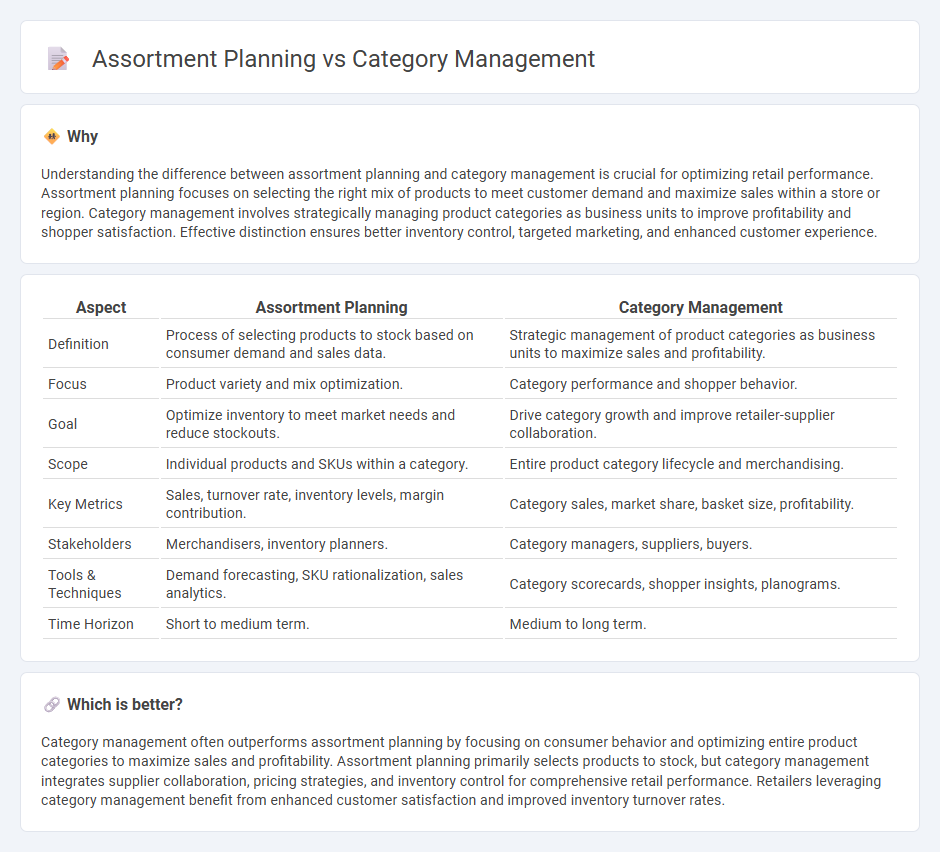
Assortment planning focuses on selecting the right mix of products to meet customer demand and maximize sales within a retail space, while category management organizes products into specific groups to optimize merchandising and inventory decisions. Understanding the strategic differences between these approaches enhances inventory efficiency, customer satisfaction, and profitability. Explore how leveraging both methods can transform your retail operations.
Why it is important
Understanding the difference between assortment planning and category management is crucial for optimizing retail performance. Assortment planning focuses on selecting the right mix of products to meet customer demand and maximize sales within a store or region. Category management involves strategically managing product categories as business units to improve profitability and shopper satisfaction. Effective distinction ensures better inventory control, targeted marketing, and enhanced customer experience.
Comparison Table
| Aspect | Assortment Planning | Category Management |
|---|---|---|
| Definition | Process of selecting products to stock based on consumer demand and sales data. | Strategic management of product categories as business units to maximize sales and profitability. |
| Focus | Product variety and mix optimization. | Category performance and shopper behavior. |
| Goal | Optimize inventory to meet market needs and reduce stockouts. | Drive category growth and improve retailer-supplier collaboration. |
| Scope | Individual products and SKUs within a category. | Entire product category lifecycle and merchandising. |
| Key Metrics | Sales, turnover rate, inventory levels, margin contribution. | Category sales, market share, basket size, profitability. |
| Stakeholders | Merchandisers, inventory planners. | Category managers, suppliers, buyers. |
| Tools & Techniques | Demand forecasting, SKU rationalization, sales analytics. | Category scorecards, shopper insights, planograms. |
| Time Horizon | Short to medium term. | Medium to long term. |
Which is better?
Category management often outperforms assortment planning by focusing on consumer behavior and optimizing entire product categories to maximize sales and profitability. Assortment planning primarily selects products to stock, but category management integrates supplier collaboration, pricing strategies, and inventory control for comprehensive retail performance. Retailers leveraging category management benefit from enhanced customer satisfaction and improved inventory turnover rates.
Connection
Assortment planning and category management are interconnected through their shared goal of optimizing product selection to maximize sales and profitability within retail stores. Assortment planning focuses on selecting the right mix of products based on consumer demand, sales data, and market trends, while category management uses this assortment data to strategically manage product categories, improve shopper experience, and drive category growth. Together, they enable retailers to align inventory with customer preferences, reduce stockouts, and increase overall retail effectiveness.
Key Terms
Product Segmentation
Product segmentation is crucial in both category management and assortment planning, where category management involves grouping products based on consumer behavior and market trends to optimize overall category performance. Assortment planning focuses on selecting the right mix of products within those segments to maximize sales and meet specific customer needs. Explore deeper insights on how effective product segmentation drives strategic decisions in retail management.
SKU Rationalization
Category management integrates SKU rationalization to optimize product groupings based on consumer demand, sales performance, and profitability metrics. Assortment planning focuses on SKU rationalization by selecting the optimal mix of products that balance inventory costs with market trends and shelf space constraints. Explore how integrating both strategies can enhance SKU rationalization and drive retail success.
Space Allocation
Category management optimizes product grouping to enhance shopper experience and maximize sales, while assortment planning determines the specific products offered within each category. Space allocation plays a critical role by ensuring high-demand and high-margin products receive prime shelf placement, influencing turnover rates and inventory efficiency. Discover how strategic space allocation techniques can transform retail profitability and customer satisfaction.
Source and External Links
Category management: Deliver a customer-first strategy - Category management is a customer-centric retail and supply chain approach that treats each product category as a separate business unit to optimize assortment, pricing, placement, and promotions based on customer behavior, improving sales and profitability.
Category management - Wikipedia - Category management organizes a retailer's products into distinct, related groups managed as "mini businesses" with collaborative supplier relationships aimed at maximizing turnover and profit of the entire category.
What is Category Management in 2024? - Procurify - Category management is a strategic procurement and supply chain approach that emphasizes cross-functional collaboration, continuous improvement, and technology adoption to optimize product categories and drive business growth.
 dowidth.com
dowidth.com